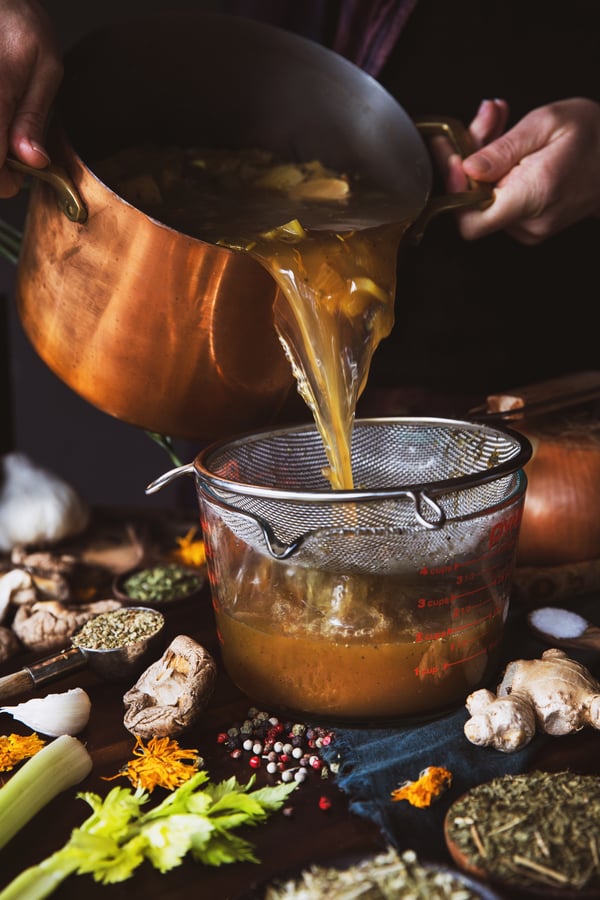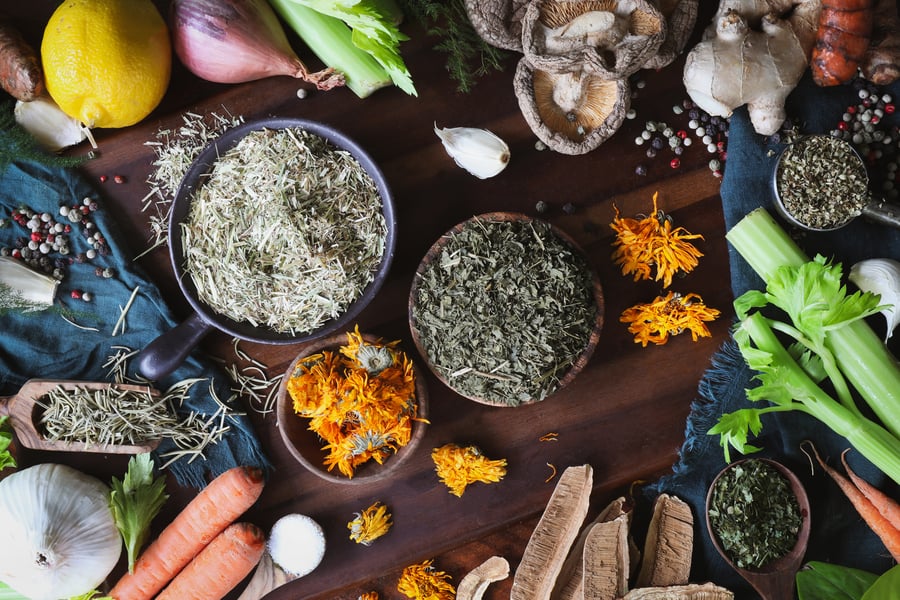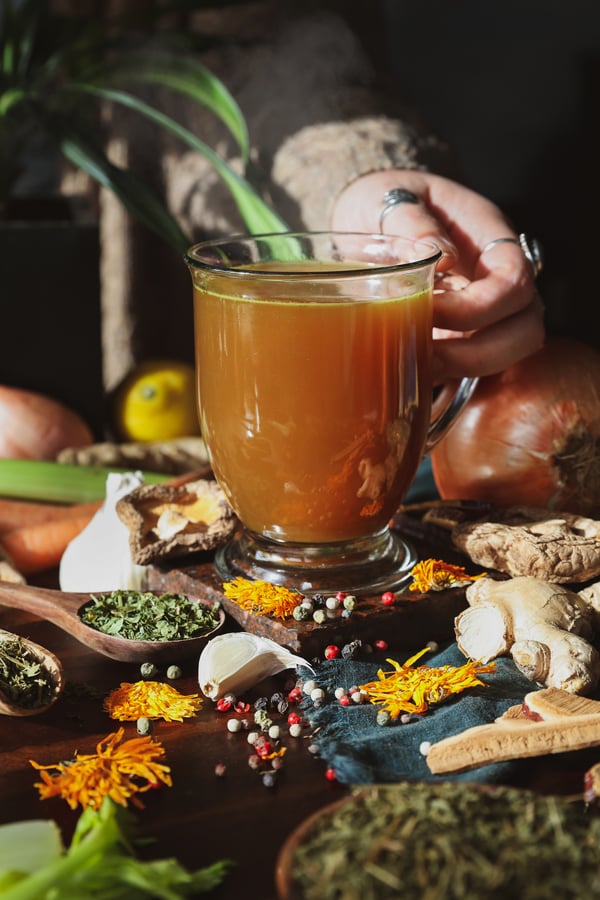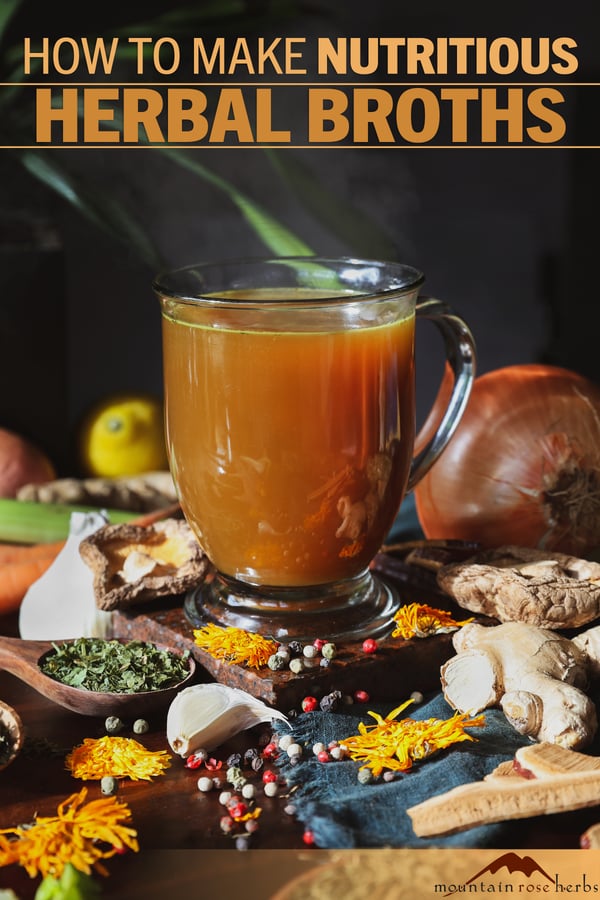I am a firm believer in broths for their gut-supporting, extremely tasty, and nourishing qualities. You can pack so much nutrition in each little sip. Adding a myriad of herbs to our broth base is the perfect vehicle for incorporating wellness into our modern lives.
There are so many ways to make an herbal broth. I suggest getting in the kitchen to experiment on your own. Trust your intuition for what your body is currently craving nutritionally. Be creative and use what you have on hand because this is also a sustainable way to use up all the food scraps from meals throughout the month. If you have the space in your freezer, save all your carrot ends, onion tops, apple cores, celery bulbs, mushrooms, and herb stems in a freezer-safe container over time and pull out all those saved ingredients when it comes time to make the broth. For more inspiration on what to add, see the list below.
Now the question is why make an herbal broth? Well, it makes a wonderful sipping beverage with nutritional benefits, a flavorful main ingredient for cooking meals such as soups, stews, or sauces, and it enhances the taste of grains like rice, quinoa, or couscous. You can even splash some in a savory stir-fry dish.
Prepare the broth either in a pot on the stove or add all the ingredients and let them slowly cook in a crock pot. I do love using a crock pot to slow-cook for convenience purposes. The broth ingredients are easy to throw together in the morning or before bed. When preparing on the stove, simmer on low for at least 20 minutes and up to 1 hour. Start with the vegetables, roots, mushrooms, and greens first. Add in the aromatic herbs at the end, particularly more delicate plant parts such as flowers, leaves, and stems, because you don’t want to boil those. You could even take the pot off the heat and add them, letting them infuse for up to an hour. If you do add them in earlier in the cooking process, make sure it's at a very low simmer while cooking.
When finishing up the broth, turn off the heat and let cool before straining. I generally strain broths through a muslin cloth or a fine mesh strainer. Make sure to strain out all the plant material because it can cause spoilage faster if left in.
How to Store Homemade Herbal Broths
You can store your broth in the fridge in a mason jar for a few days. One of my favorite methods is to pour the broth into ice cube trays to freeze for later to have these prepped and ready for a busy time or sick day. No one wants to do anything when they’re sick, so having something on hand to heat up quickly is very convenient and helps nourish an unwell body.
How to Make a Tasty Herbal Broth
Now let’s talk about flavors. For a broth with more earthy, nutty tones packed with nutrition and potential immune support, add fresh or dried mushrooms. Mushrooms also have fiber and protein that will instantly enhance the value of this herbal broth. My personal favorites are shiitake, lion’s mane, and reishi. Use what you have on hand. Use what’s in season and local to you, when you can. There’s a mushroom farm local to my area that I love to visit their booth at the farmer’s market to grab my ingredients for the week.
Besides the tried-and-true culinary herb classics like parsley, sage, thyme, cilantro, rosemary, oregano, and basil, some of my favorite herbs are stinging nettles (Urtica dioca) and oatstraw (Avena sativa) for their vitamin and mineral qualities. I would do both of those as fresh or dried ingredients. When adding mineral herbs, I also like to add a splash of apple cider vinegar to help draw out those minerals.
Include roots like ginger for its spicy, warming aromatic qualities and turmeric for its potent musky-peppery flavor that adds a gorgeous golden hue to your final product. Lemongrass is one of my favorite annuals to grow in my garden and it makes a wonderful addition to the herbal broth for that lemony citrus flavor. Another favorite addition is calendula flowers. They brighten the broth with their golden petals and support the digestive system.
Some ingredients can make herbal broth less appealing, such as bitter-flavored herbs and vegetables. Keep Brassica vegetables (Broccoli, Cabbage, Kale, etc.) out of the broths unless they will be added into a strongly flavored soup straight away. Also, avoid starchy vegetables like potatoes that tend to make the broth cloudy. Woody culinary herbs like rosemary, thyme, and sage can get bitter and overpowering, so use them gently.
As always, remember when you consume this delicious and nutritious herbal broth, honor all the farmers, foragers, and gardeners, including your wonderful self, who worked hard to share these herbs with you.
Ingredients to Make Homemade Vegetarian Broths
Organic Vegetables
- Apple cores (de-seed)
- Carrot roots and greens
- Celery and celery seeds
- Onions, Shallots, or Leaks
- Garlic
- Mushrooms
- Lemons or Limes (use whole or juice and use the rinds)
Organic Herbal additions
- Astragalus root (Astragalus membranaceus)
- Bee Balm (Monarda fistulosa)
- Calendula (Calendula officinalis)
- Dandelion leaves fresh or dried (Taraxacum officinale)
- Ginger (Zingiber officinale)
- Lemongrass (Cymbopogon citratus)
- Moringa (Moringa oleofera)
- Oatstraw (Avena sativa)
- Seaweeds of all types and flavors
- Stinging Nettles (Urtica dioica)
- Turmeric (Curcuma longa)
Organic Mushroom additions (dried or fresh)
- Reishi (Ganoderma lucidum)
- Shiitake (Lentinula edodes)
- Maitake (Grifola frondosa)
- Turkey tail (Trametes versicolor)
- Lion’s mane (Hericium erinaceus)
Base Herbal Broth Recipe
Here’s an example recipe I create often. The ingredients are a good baseline, but I’ll go with what’s on hand, in season, local to my area, or what I’ve preserved for later. This is a smaller batch. I never measure my ingredients and throw in what I feel at that moment. The idea is to have a nice thick slurry with all your herbs and veggies. Happy cooking!
Ingredients
- 2 Tbsp. organic extra virgin olive oil
- Pinch of salt & pepper
- 1 organic red or yellow onion, chopped
- 2-4 pieces of organic celery, chopped
- 1-3 organic carrots, chopped, (also use the greens if attached and fresh)
- 2-3 slices dried organic reishi mushroom
- 1/4 cup dried organic shiitake mushrooms
- 1 organic garlic bulb (add more if you love garlic)
- 2 Tbsp. fresh organic ginger root
- 2 Tbsp. fresh organic turmeric root
- 2 whole organic lemongrass bulbs (dried or fresh)
- Saved food scraps (optional)
- 12 cups of water or more water as needed
- Large pinches of any dried culinary herbs on hand: parsley, sage, oregano, thyme, and rosemary (use twice as much if using fresh herbs)
- 1 cup dried organic oatstraw leaves
- 1 cup dried organic stinging nettles leaves
- 1/4 cup dried organic calendula flowers
- 1 Tbsp. organic apple cider vinegar
- Peels of 2 lemons
Directions
- In a large pot over medium heat, add in the olive oil, salt, and onions for 2-3 minutes or until onions are translucent.
- Add in celery, carrots, mushrooms, garlic, fresh ginger, fresh turmeric, lemongrass, or food scraps of choice to the pot. Cook for about 3-5 minutes.
- Add in the water and increase to high heat until the mixture has reached a boil.
- Reduce heat to a low or simmer broth for 20 to 60 minutes.
- Add in all remaining ingredients while simmering.
- Strain the broth.
Looking to Learn More From Alex?
Check Her Out at TendingTheWildFlowers.com
You may also enjoy:
- How to Use TCM Herbs for Nourishing Soups
- Vegan Pho Recipe with Mushrooms
- Mushroom Bouillon Powder & Paste Recipes














